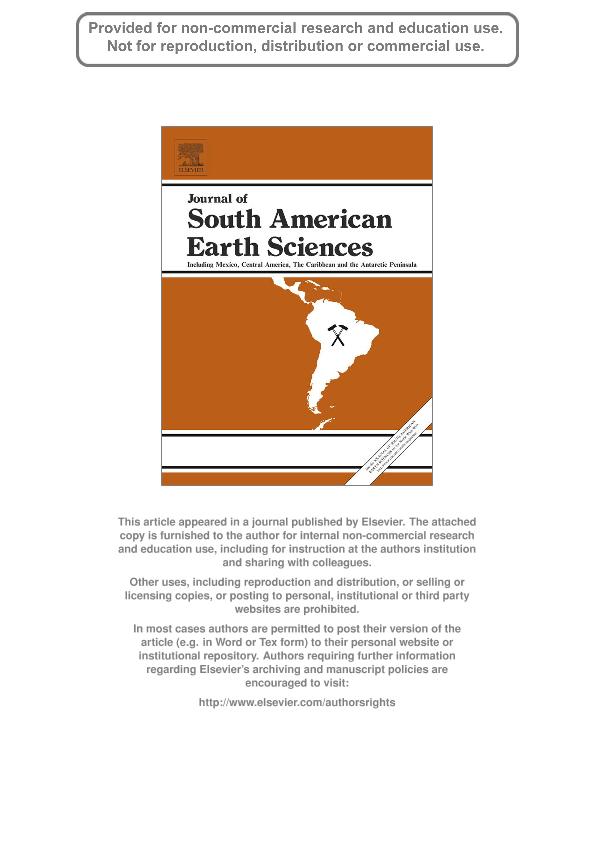Mostrar el registro sencillo del ítem
dc.contributor.author
Armella, Claudia

dc.contributor.author
Cabaleri, Nora Graciela

dc.contributor.author
Cagnoni, Mariana Celina

dc.contributor.author
Panarello, Hector Osvaldo

dc.date.available
2017-06-16T18:24:57Z
dc.date.issued
2013-08
dc.identifier.citation
Armella, Claudia; Cabaleri, Nora Graciela; Cagnoni, Mariana Celina; Panarello, Hector Osvaldo; Early Callovian ingression in southwestern Gondwana. Palaeoenvironmental evolution of the carbonate ramp (Calabozo Formation) in southwestern Mendoza, Neuquen basin, Argentina; Elsevier; Journal Of South American Earth Sciences; 45; 8-2013; 293-315
dc.identifier.issn
0895-9811
dc.identifier.uri
http://hdl.handle.net/11336/18319
dc.description.abstract
The carbonatic sequence of the Calabozo Formation (Lower Callovian) developed in southwestern Gondwana, within the northern area of the Neuquén basin, and is widespread in thin isolated outcrops in southwestern Mendoza province, Argentina. This paper describes the facies, microfacies and geochemical-isotopic analysis carried out in five studied localities, which allowed to define the paleoenvironmental conditions of a homoclinal shallow ramp model, highly influenced by sea level fluctuations, where outer, mid and inner ramp subenvironments were identified. The outer ramp subenvironment was only recognized in the south of the depocenter and is characterized by proximal outer ramp facies with shale levels and interbedded mudstone and packstone layers. The mid ramp subenvironment is formed by low energy facies (wackestone) affected by storms (packstones, grainstones and floatstones). The inner ramp subenvironment is the most predominant and is characterized by tidal flat facies (wackestones, packstones and grainstones) over which a complex of shoals (grainstones and packstones) dissected by tidal channels (packstone, grainstones and floatstones) developed. In the north area, protected environment facies were recorded (bioturbated wackestones and packstones). The vertical distribution of facies indicates that the paleoenvironmental evolution of the Calabozo Formation results from a highstand stage in the depocenter, culminating in a supratidal environment, with stromatolitic levels interbedded with anhydrite originated under restricted water circulation conditions due to a progressive isolation of the basin. δ13C and δ18O values of the carbonates of the Calabozo Formation suggest an isotopic signature influenced by local palaeoenvironmental parameters and diagenetic overprints. The δ13C and δ18O oscillations between the carbonates of the different studied sections are related with lateral facies variations within the carbonate ramp accompanied with dissimilar reactivities in relation to diagenetic fluids. The δ18O values of all sections exhibit a rather broad scatter which may be attributed to diagenesis and recrystallisation while the carbon isotopic composition has been less affected by those processes. Carbon isotope system has best retained the primary isotopic signal and δ13C values (0–3.9‰) are within the Callovian isotope range. The 87Sr/86Sr ratios of the bulk carbonates of El Plomo creek, La Vaina creek and Potimalal River sections are in agreement with the Callovian seawater Sr-isotope curve.
dc.format
application/pdf
dc.language.iso
eng
dc.publisher
Elsevier

dc.rights
info:eu-repo/semantics/openAccess
dc.rights.uri
https://creativecommons.org/licenses/by-nc-sa/2.5/ar/
dc.subject
Carbonate Ramp
dc.subject
Stable Isotopes
dc.subject
Facies Microfacies
dc.subject
Callovian Neuquen
dc.subject.classification
Geoquímica y Geofísica

dc.subject.classification
Ciencias de la Tierra y relacionadas con el Medio Ambiente

dc.subject.classification
CIENCIAS NATURALES Y EXACTAS

dc.title
Early Callovian ingression in southwestern Gondwana. Palaeoenvironmental evolution of the carbonate ramp (Calabozo Formation) in southwestern Mendoza, Neuquen basin, Argentina
dc.type
info:eu-repo/semantics/article
dc.type
info:ar-repo/semantics/artículo
dc.type
info:eu-repo/semantics/publishedVersion
dc.date.updated
2017-06-16T15:21:04Z
dc.journal.volume
45
dc.journal.pagination
293-315
dc.journal.pais
Países Bajos

dc.journal.ciudad
Amsterdam
dc.description.fil
Fil: Armella, Claudia. Consejo Nacional de Investigaciones Científicas y Técnicas. Oficina de Coordinación Administrativa Ciudad Universitaria. Instituto de Geocronología y Geología Isotopica. Universidad de Buenos Aires. Facultad de Ciencias Exactas y Naturales. Instituto de Geocronología y Geología Isotopica; Argentina
dc.description.fil
Fil: Cabaleri, Nora Graciela. Consejo Nacional de Investigaciones Científicas y Técnicas. Oficina de Coordinación Administrativa Ciudad Universitaria. Instituto de Geocronología y Geología Isotopica. Universidad de Buenos Aires. Facultad de Ciencias Exactas y Naturales. Instituto de Geocronología y Geología Isotopica; Argentina
dc.description.fil
Fil: Cagnoni, Mariana Celina. Consejo Nacional de Investigaciones Científicas y Técnicas. Oficina de Coordinación Administrativa Ciudad Universitaria. Instituto de Geocronología y Geología Isotopica. Universidad de Buenos Aires. Facultad de Ciencias Exactas y Naturales. Instituto de Geocronología y Geología Isotopica; Argentina
dc.description.fil
Fil: Panarello, Hector Osvaldo. Consejo Nacional de Investigaciones Científicas y Técnicas. Oficina de Coordinación Administrativa Ciudad Universitaria. Instituto de Geocronología y Geología Isotopica. Universidad de Buenos Aires. Facultad de Ciencias Exactas y Naturales. Instituto de Geocronología y Geología Isotopica; Argentina
dc.journal.title
Journal Of South American Earth Sciences

dc.relation.alternativeid
info:eu-repo/semantics/altIdentifier/doi/http://dx.doi.org/10.1016/j.jsames.2013.03.013
dc.relation.alternativeid
info:eu-repo/semantics/altIdentifier/url/http://www.sciencedirect.com/science/article/pii/S0895981113000503?via%3Dihub
Archivos asociados
